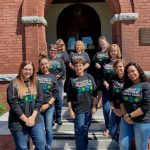PROGRAM OUTLINE
Overview
The course of treatment is divided into orientation and four major phases. Goals for each phase are centered around the individual treatment plan, Recovery Dynamics (1), and successful management of expectations of the court. Each participant is assigned a case manager and is expected to wear a drug patch (continuous screening for illicit drugs). Some participants are on Antabuse because of a primary diagnosis of alcoholism. The patch is worn continuously.
Each participant is required to attend at least two AA/NA meetings per week outside of treatment, obtain a temporary, then permanent sponsor, stay clean, be on time for all meetings, obtain employment that supports recovery, obtain or work toward a GED, pay fine in a timely fashion, attend court weekly (except in third and fourth phases), and attend all treatment sessions.
ORIENTATION: Six to eight weeks.
Major focus: Stabilization, ambulatory detoxification, introduction to post acute withdrawal, introduction to disease concept including relapse behavior, presentation of Drug Court expectations, and development of second treatment plan.
PHASE 1: Six months
Major focus: Introduction to tools for recovery, motivation for change, continual presentation of disease concept including mental, physical, and spiritual issues, step one of self-help programs. Case management focuses on stabilization of living arrangements, employment, and family stabilization, and paying fee.
Major tools for this phase:
- lecture/film series and discussion on all aspects of the disease concept
- Recovery Dynamics
- AA/NA talks at the court
- drug patches, Antabuse, and random drug screens
- group process, conflict resolution, and problem solving
Goals:
- Participants should be able to list and verbally explain how the disease of addiction has affected their life.
- Participant should demonstrate ways of managing stress.
- The participants shall demonstrate the importance of not substituting one drug for another and begin to develop a healthy lifestyle.
- The participant should complete assigned Recovery Dynamics work, complete a first step, and be prepared to move to Phase II.
- The participant shall engage in sober living activities.
- The participant shall become accountable for actions.
PHASE II: Six months
Major focus:
- Mood stabilization
- Improvement of participants ability to experience and manage full range of emotions without use of drugs and alcohol.
- Recovery Dynamics around Step II of AA.
- Continued understanding of the disease of addiction.
Major tools:
- group process, question/answer sessions
- attendance at all required meetings including AA/NA.
- Recovery Dynamics
- Lecture/films on feelings/emotions
- Drug patches, Antabuse, random screens
- Mood stabilization techniques
Goals:
- Participants should understand all court and treatment schedules including drug screens demonstrated by compliance.
- Participants should manage withdrawal symptoms and crisis by asking for help if needed.
- Participants will learn to identify and distinguish major emotional states including fear, anger, anxiety, joy, grief, happiness, love, hurt, guilt, shame, and resentment.
- Participants will learn to express and safely release intense feeling states without harm to self or others.
- Participants will demonstrate the ability to routinely integrate emotions into life experience.
- Participants will learn to respond productively to various emotional stimuli rather than simply react without the due consideration of consequences.
- Participants will demonstrate in group with peers the successful management of a crisis situation with skills other than use of substances.
- Participants will learn social and communication skills through the experience of group process.
PHASE III: Thirteen weeks
Major focus:
- Disease concept as it effects the family
- Issues relating to adult children of addicts
- Stabilizing the family structure
Major tools:
- group process including family members
- family/couples counseling
- lectures, films, discussions about family issues
- Recovery Dynamics
- Continued AA/NA involvement
- Drug patch, random screens
- specialized groups in relationships, pregnancy, gender
Major Goals:
- Participants with one year continuous sobriety will wear drug patch only every other week.
- Participants will demonstrate commitment to sobriety by asking significant others to attend drug court meetings and to attend Alanon.
- Participants will complete Step III and move to next step.
PHASE IV:
Major focus:
- Return to community a responsible, productive citizen.
Major tools:
- group process/dual diagnosis, relationship issues
- financial management workshops
- vocational training or college preparation
- random drug screens
- continued AA/NA involvement
Major Goals:
- Participants will develop and present a relapse prevention strategy.
- Participants will complete a community service project.
- Participants will demonstrate active participation in AA/NA or other 12-Step Program.
- Participants will successfully complete a cognitive restructuring/decision making course.
- Participant will complete GED during this phase.
- Participant will mentor newer members of the court.
Source
1. Recovery Dynamics: A Twelve-Step workbook developed by Kelly and Associates, Little Rock, Arkansas








